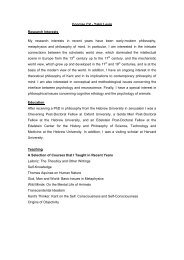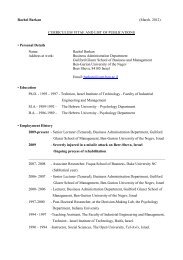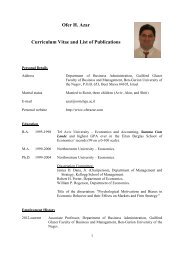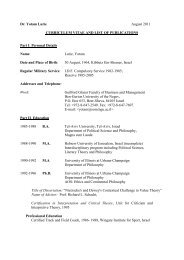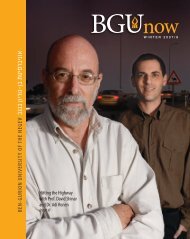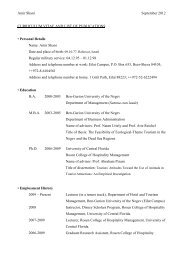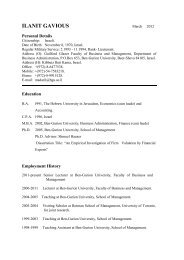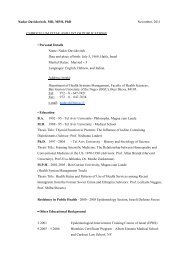cover 2006
cover 2006
cover 2006
Create successful ePaper yourself
Turn your PDF publications into a flip-book with our unique Google optimized e-Paper software.
Prof. Yuval Shahar<br />
An Enterprising Magician<br />
32 BGU NOW<br />
W<br />
hat happens when you cross a<br />
math genius with a future<br />
doctor? To that theoretical question<br />
we give one answer: Prof. Yuval<br />
Shahar. Shahar is one of the few who<br />
have combined the study of<br />
medicine (for a medical degree at<br />
the Hebrew University of Jerusalem)<br />
with mathematics and computers<br />
(for a Masters degree at Bar-Ilan<br />
University), which has placed him<br />
at the forefront of the emerging field<br />
of Medical Bioinformatics. After his<br />
military service as a medic he won<br />
a scholarship for a Masters program<br />
at Yale University, where he studied<br />
artificial intelligence (AI).<br />
Two years later, he was accepted<br />
to a doctoral program at Stanford<br />
University headed by Prof. Edward<br />
Shortliffe. Stanford is the academic<br />
world’s center of medical<br />
informatics and it was there that<br />
Shahar was truly bitten by the<br />
medical informatics bug. He was to<br />
spend ten years in Stanford, first as<br />
a doctoral student, then a faculty<br />
member, and was the recipient of<br />
several prestigious prizes and<br />
awards, including a National<br />
Institute of Health 5-year personal<br />
FIRST award for research and an<br />
award from the National Science<br />
Foundation to develop his<br />
theoretical work on temporal<br />
reasoning.<br />
Shahar came from Stanford to<br />
BGU in 2000, joining the Department<br />
of Information Systems Engineering,<br />
which he now chairs. He also<br />
established the Medical Informatics<br />
Research Center (MIRC) which he<br />
heads, thus making the jump from<br />
theoretical to applied research.<br />
Shahar and his team of researchers<br />
use AI technology to develop<br />
complex computer programs that<br />
are capable of monitoring and<br />
processing large amounts of data<br />
over lengthy time periods. This<br />
technology has earned Shahar the<br />
reputation as an international expert<br />
in automated medical-decision<br />
support systems.<br />
The names of these complex<br />
computer programs have roots in<br />
several languages: from the Hebrew<br />
IDAN (epoch) and DeGel (flag) to<br />
Vayduria (a Tibetan healer) to the<br />
acronym KNAVE, for Knowledgebased<br />
Navigation, Abstraction,<br />
Visualization and Exploration. But<br />
the one he describes with the most<br />
enjoyment evokes associations in all<br />
English-speakers: the Spock Hybrid<br />
Runtime Application Model – or,<br />
simply, “Spock,” named after Mr.<br />
Spock of the 1960s TV series Star<br />
Trek.<br />
“Various medical associations in<br />
the United States produce what they<br />
call ‘guidelines’ for physicians,”<br />
explains Shahar. “These are text<br />
guides with explanations of how to<br />
treat everything from hypertension<br />
to diabetes and they are very useful,<br />
but few physicians actually use<br />
them because of lack of time. One<br />
of my goals was to computerize<br />
these guidelines into a more<br />
available format for diagnostic<br />
purposes. Also, these guidelines<br />
often <strong>cover</strong> conditions in a general<br />
way, such as ‘treatment of diabetes,’<br />
while Spock allows greater<br />
complexity, such as ‘diabetes in a<br />
pregnant woman with high blood<br />
pressure.’<br />
“Another problem I wanted to<br />
solve was the large amounts of data<br />
that a physician must process in a<br />
short amount of time. Family<br />
doctors may treat patients who have<br />
suffered from diabetes for decades;<br />
these patients accumulate results of<br />
tests with hundreds of items of data.<br />
The physician must monitor these<br />
patients for numerous complications<br />
such as renal insufficiency,<br />
neuropathy (numbness) of limbs,<br />
ulcers or toxicity toward drugs – all<br />
Spock suggests guidelines, but the physician<br />
can overrule or modify them. It’s the doctor<br />
who's in charge<br />
this, again, in a typically short visit<br />
that must address the patient’s<br />
present complaints in the context of<br />
accumulated data that may reveal<br />
trends. Is it any wonder that the<br />
physician is likely to miss subtle<br />
patterns of change?<br />
“That’s where the KNAVE visual<br />
exploration module comes in. It<br />
relies on the underlying IDAN<br />
module, which performs what we<br />
call temporal abstraction–<br />
interpretation of clinical data<br />
accumulating over time and their<br />
summarization as clinically<br />
meaningful patterns. We’ve found<br />
that it takes only about ten minutes<br />
to teach physicians how to use<br />
KNAVE and a few seconds for the<br />
IDAN/KNAVE combination to<br />
review the online blood tests and<br />
records and then tap the doctor on<br />
the shoulder and say: this patient



